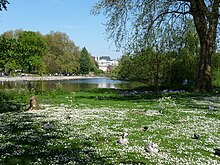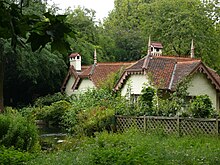Usuário:Eduardo P/St. James's Park





O St. James's Park (Parque de São Tiago) é um parque de 23 hectares (57 acres)[1] situado na zona de Westmister, no centro de Londres - o mais antigo dos parques reais de Londres.[2] O parque fica no extremo sul da área de St. James, que foi nomeado após um hospital de leprosos dedicado a São Tiago Menor.
Localização geográfica
[editar | editar código-fonte]O parque de St. James é delimitado pelo Palácio de Buckingham a oeste, The Mall e o Palácio de St. James ao norte, Horse Guards a leste e Bridcage Walk ao sul.
História
[editar | editar código-fonte]In 1532, Henry VIII purchased from Eton College an area of marshland, through which the Tyburn flowed. This land lay to the West of York Place, recently acquired by Henry from Cardinal Wolsey; it was purchased in order to turn York Palace into a dwelling fit for a king. On James I's accession to the throne in 1603, he ordered that the park be drained and landscaped, and kept exotic animals in the park, including camels, crocodiles, and an elephant, as well as aviaries of exotic birds along the south.
During Charles II's exile in France under the Commonwealth of England, the young king was impressed by the elaborate gardens at French royal palaces, and on his ascension had the park redesigned in a more formal style, probably by the French landscaper André Mollet. This included the creation of the 775 by 38 metre (850 by 42 yard) canal visible in the old plan. Charles II opened the park to the public, as well as using the area to entertain guests and mistresses, such as Nell Gwyn. The park was notorious at the time as a meeting place for acts of degeneracy, of which John Wilmot, 2nd Earl of Rochester wrote in his poem A Ramble in St. James's Park.
In the late 17th and early 18th century cows were grazed on the park, and milk could be bought fresh at the "Lactarian", described by Zacharias Conrad von Uffenbach in 1710.[3]
The 18th century saw further changes, including the reclamation of part of the canal for Horse Guards Parade and the 1761 purchase of Buckingham House (now Buckingham Palace) at the west end of the Mall, for the use of Queen Charlotte.
Further remodelling in 1826–7, commissioned by the Prince Regent (later George IV) and overseen by the architect and landscaper John Nash, saw the straight canal's conversion to a more naturally-shaped lake, and formal avenues rerouted to romantic winding pathways. At the same time, Buckingham House was expanded to create the current palace and Marble Arch was built at its entrance, whilst The Mall was turned into a grand processional route, opened to public traffic 60 years later in 1887, the Marble Arch having been moved to its current location at the junction of Oxford Street and Park Lane in 1851 and replaced with the Victoria Memorial between 1906 and 1924.
References
[editar | editar código-fonte]- ↑ «St. James's Park». Royalparks.org.uk. Consultado em 5 de dezembro de 2011
- ↑ St. James's Park - History[ligação inativa]
- ↑ Cockayne, Emily (2007). Hubbub: Filth Noise & Stench in England. [S.l.]: Yale University Press. p. 100. ISBN 978-0-300-13756-9
External links
[editar | editar código-fonte]- St. James's Park RoyalParks.gov
Text is available under the CC BY-SA 4.0 license; additional terms may apply.
Images, videos and audio are available under their respective licenses.


